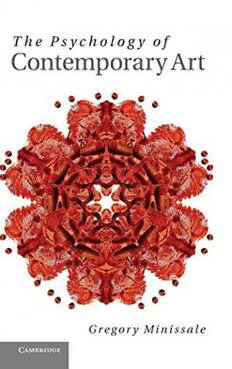
The Psychology of Contemporary Art PDF
Preview The Psychology of Contemporary Art
The Psychology of Contemporary Art Whilerecentstudiesinneuroscienceandpsychologyhaveshedlighton oursensoryandperceptualexperiencesofart,theyhaveyettoexplain how contemporary art downplays perceptual responses and, instead, encourages conceptual thought. The Psychology of Contemporary Art brings together the most important developments in recent scientific research on visual perception and cognition and applies the results of empirical experiments to analyses of contemporary artworks not nor- mallyaddressedbypsychologicalstudies.Theauthorexplains,insimple terms, how neuroaesthetics, embodiment, metaphor, conceptual blending,situatedcognitionandextendedmindofferfreshperspectives on specific contemporary artworks – including those of Marina Abramovic´,Francis Alÿs, MartinCreed,Tracy Emin,Felix Gonzales- Torres, Marcus Harvey, Mona Hatoum, Thomas Hirschorn, Gabriel Orozco, Marc Quinn and Cindy Sherman. This book will appeal to psychologists, cognitive scientists, artists and art historians, as well as thoseinterestedinadeeperunderstandingofcontemporaryart. GregoryMinissaleisaSeniorLecturerintheDepartmentofArtHistory at the University of Auckland where he teaches contemporary art and theory.HeistheauthorofFramingConsciousnessinArt(2009)andImages ofThought(2006). The Psychology of Contemporary Art Gregory Minissale UniversityPrintingHouse,CambridgeCB28BS,UnitedKingdom PublishedintheUnitedStatesofAmericabyCambridgeUniversityPress,NewYork CambridgeUniversityPressispartoftheUniversityofCambridge. ItfurtherstheUniversity’smissionbydisseminatingknowledgeinthepursuitof education,learning,andresearchatthehighestinternationallevelsofexcellence. www.cambridge.org Informationonthistitle:www.cambridge.org/9781107019324 ©GregoryMinissale2013 Thispublicationisincopyright.Subjecttostatutoryexception andtotheprovisionsofrelevantcollectivelicensingagreements, noreproductionofanypartmaytakeplacewithoutthewritten permissionofCambridgeUniversityPress. Firstpublished2013 PrintingintheUnitedKingdombyTJInternationalLtd.PadstowCornwall AcataloguerecordforthispublicationisavailablefromtheBritishLibrary ISBN978-1-107-01932-4Hardback CambridgeUniversityPresshasnoresponsibilityforthepersistenceoraccuracyof URLsforexternalorthird-partyinternetwebsitesreferredtointhispublication, anddoesnotguaranteethatanycontentonsuchwebsitesis,orwillremain, accurateorappropriate. For my mother, Pat Bird, kind above all others Contents Listoffigures pagex Preface xiii Acknowledgements xxiii Eightmajortrendsincontemporaryart xxv PartI Introduction 1 1.1 Processesofperception 1 1.2 Concepts 5 1.3 Thecooperationofperceptionswithconcepts 13 1.4 Sceneandobjectrecognition 22 1.5 Objectrecognition 25 1.6 Granularityinscenerecognition 32 1.7 Objectcategorisation 36 1.8 Schemata 44 1.9 Perceptualsymbolsystemsandart 51 1.10 ‘Illogical’hybridobjects 58 1.11 Facialrecognition 64 1.12 Expertobjects 70 PartII Brain 75 2.1 Neuroaesthetics 75 2.2 Emotionsinart:seeingisbelieving? 84 vii viii Contents 2.3 Dynamicinterconnectivity 109 2.4 Convergencezones 116 2.5 Wordandimageincontemporaryart 119 2.6 Modelsofaestheticcognition 130 2.7 Relationalknowledge 139 2.8 Analogicalprocessesinrelationalknowledge 145 2.9 CarlAndre’sLever,1966 150 2.10 Metaphorandart 160 2.11 Thestructuresofmetaphorinart 164 PartIII Body 175 3.1 Embodiedapproachestoart 175 3.2 Phenomenologicalapproachesinarthistory 182 3.3 Actionasperception 194 3.4 Contra-normativeembodiment 199 3.5 Disguisedbodies 208 3.6 Queerobjectsandinvisiblebodies 212 3.7 Contemporaryartandtheself 225 3.8 Theselfandneuropsychology 233 3.9 Losingoneself:mindwandering 240 PartIV World 251 4.1 Doescontemporaryartsituatecognition? 251 4.2 Evaluatingsituatedcognition 263 4.3 Clark’sextendedmind 270 4.4 Conceptualblending 277 4.5 Blendingtime 280 4.6 ‘Invisible’blends 286
